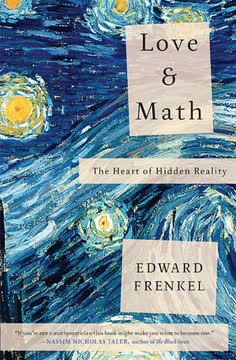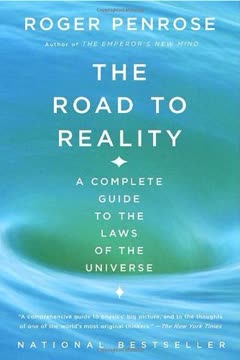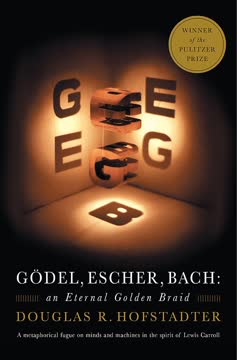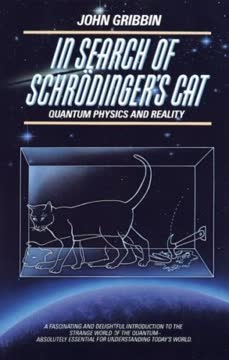Key Takeaways
1. Mathematics is a hidden world of profound beauty and elegance.
There’s a secret world out there. A hidden parallel universe of beauty and elegance, intricately intertwined with ours.
Beyond school math. Most people only encounter a small, often dry, part of mathematics in school, like painting a fence without seeing masterpieces. This hides the vibrant, advanced world of modern math, full of infinite possibilities, elegance, and beauty, comparable to poetry, art, and music. It's a world invisible to most, yet deeply woven into our daily lives through technology.
A universal language. Mathematics is not just a toolkit for science; it's a fundamental language describing reality itself. Galileo famously stated that the laws of nature are written in math. It allows for groundbreaking leaps, like Einstein's understanding of curved space, which were not based on existing data but on mathematical theory.
An extra sense. Engaging with mathematics provides a unique way to perceive and understand the universe. Charles Darwin regretted not pursuing math, feeling that those endowed with it seemed to possess "an extra sense." It offers a powerful lens to analyze reality, free from dogma, fostering innovation and revealing hidden structures.
2. Symmetry is a universal principle unifying diverse mathematical concepts.
Experience shows that symmetry is an essential guiding principle for the laws of nature.
Defining symmetry. Symmetry isn't just about visual balance in objects like butterflies or snowflakes; mathematically, it's defined by transformations that preserve an object's shape and position. The more such transformations an object allows, the more symmetrical it is. These transformations form a "group," a set with specific rules for composition.
Groups in action. The concept of a group extends beyond geometry. It provides a powerful abstract tool applicable in various domains:
- Rotations of a square form a finite group.
- Rotations of a circle form an infinite group (the circle group).
- Integers under addition form a group.
- Braids with a fixed number of threads form a group.
Unifying principle. Symmetry groups are crucial in physics, classifying elementary particles and predicting their existence. The group SU(3), for instance, explained the patterns of hadrons and led to the quark model. This demonstrates how abstract mathematical concepts reveal fundamental truths about the physical world.
3. Passion for knowledge can overcome systemic discrimination and adversity.
They didn’t let me in through the front door; I flew in through a window.
Facing the "fifth line". Growing up in the Soviet Union, the author encountered institutional anti-Semitism, particularly in university admissions. Despite excelling academically and in entrance exams, his Jewish background ("the fifth line" in his passport) led to blatant discrimination and denial of entry to Moscow State University (MGU).
Finding alternative paths. Refusing to be deterred, the author found ways to pursue his passion. He enrolled in a less prestigious institute (Kerosinka) known for accepting Jewish students and secretly attended lectures and seminars at MGU by scaling the fence. This period highlights the resilience required to pursue intellectual goals against oppressive systems.
A haven for talent. Kerosinka became a de facto haven for bright students excluded from MGU, fostering a stimulating environment despite its applied focus. This informal network, along with dedicated mentors, provided the crucial support needed to continue studying pure mathematics and eventually gain recognition abroad, bypassing the discriminatory barriers.
4. Mentorship is essential for navigating the path of mathematical discovery.
Looking back, it is clear to me that without Fuchs’ kindness and generosity, I would have never become a mathematician.
Guidance through the unknown. The journey into advanced mathematics is challenging and often requires guidance. The author's first mentor, Evgeny Evgenievich Petrov, introduced him to the exciting world beyond school math, providing books and weekly discussions that ignited his passion.
Opening doors. After the MGU rejection, Dmitry Borisovich Fuchs, a renowned mathematician, took the author under his wing. Fuchs provided the crucial first research problem and guidance, saving his faltering mathematical career. This mentorship was vital for gaining confidence and learning how to conduct original research.
Collaborative growth. Working with Boris Feigin, a visionary mathematician, turbocharged the author's development. Feigin's insights and collaborative approach pushed the research to new levels, leading to significant discoveries. Effective mentorship involves not just teaching, but inspiring, guiding, and fostering independence in the student.
5. The Langlands Program is a Grand Unified Theory revealing deep connections across math.
I like to think of it as a Grand Unified Theory of Mathematics because it uncovers and brings into focus mysterious patterns shared by different areas of math and thus points to deep, unexpected connections between them.
Bridging continents. Mathematics is vast, with specialized fields often feeling like separate continents. The Langlands Program, initiated by Robert Langlands, seeks to build bridges between these seemingly unrelated areas, particularly number theory and harmonic analysis. It's an ambitious project aiming for a unified understanding.
A web of connections. The program proposes deep, often unexpected, relationships between:
- Representations of Galois groups (from number theory)
- Automorphic functions (from harmonic analysis)
- Geometric objects like Riemann surfaces and their fundamental groups
- Advanced concepts like sheaves and D-branes
Unifying power. Langlands' vision provides a framework to see common patterns and structures across diverse mathematical landscapes. This unification not only helps solve previously intractable problems but also reveals a mysterious underlying source code for mathematics itself, suggesting a profound, interconnected reality.
6. Hidden harmony exists in seemingly random numerical data.
This one line is a secret code containing all information about the numbers of solutions of the cubic equation modulo all primes.
Counting solutions. A key problem in number theory is counting solutions to equations. For algebraic equations, like y² + y = x³ - x², we can count solutions not just in real or complex numbers, but also "modulo p" for prime numbers p (using arithmetic where numbers "wrap around" after reaching p).
The magic of modular forms. The number of solutions modulo p for certain equations appears random. However, mathematicians like Martin Eichler discovered that these numbers are precisely the coefficients of special functions called modular forms. These functions possess exquisite symmetries.
Generating functions. A single modular form can encode the entire sequence of solution counts for all prime numbers. This is like a generating function for Fibonacci numbers, revealing a hidden, elegant structure behind seemingly chaotic data. This connection between number theory and modular forms is a cornerstone of the Langlands Program.
7. Geometry and Number Theory are linked by a profound "Rosetta Stone" analogy.
André Weil gave us a suitable framework for understanding connections between number theory and geometry, a kind of “Rosetta stone” of modern math.
Weil's vision. Mathematician André Weil saw deep analogies between number theory and geometry. He proposed a "Rosetta Stone" with three columns:
- Number Theory (rational numbers, number fields, Galois groups)
- Curves over Finite Fields (solutions to equations modulo primes)
- Riemann Surfaces (geometric shapes like spheres, tori, defined by equations over complex numbers)
Translating concepts. Weil's insight is that concepts and theorems can often be translated between these columns. For example, rational functions on a Riemann surface are analogous to rational numbers. This allows mathematicians to use insights from one area to make conjectures and discoveries in another.
Bridging the gap. Curves over finite fields act as an intermediary, linking the abstract world of numbers to the visual world of geometry. This framework provides a powerful tool for exploring connections, including those later revealed by the Langlands Program, which finds counterparts in all three columns.
8. Modern math introduces abstract concepts like groups, fields, and sheaves to expand reality.
In modern math, we create a new world in which numbers come alive as vector spaces.
Beyond basic arithmetic. Modern mathematics operates with concepts far more abstract and powerful than the numbers and functions taught in school. These concepts provide new ways to perceive and structure reality.
Key abstract concepts:
- Groups: Formalize symmetry and structure (e.g., Lie groups describe continuous symmetries).
- Fields: Numerical systems closed under arithmetic (e.g., finite fields modulo primes).
- Vector Spaces: Generalize the notion of dimension and allow for operations beyond simple addition/multiplication of numbers.
- Sheaves: Generalize functions by assigning vector spaces (or more complex structures) to points on a geometric shape, capturing richer local information.
Categorification. This shift from simple objects like numbers and functions to richer structures like vector spaces and sheaves is part of a process called "categorification." It elevates mathematical concepts to a higher level, revealing deeper structures and relationships, and is increasingly relevant to fields like computer science.
9. The Langlands Program connects mathematics to quantum physics through duality.
And lo and behold, that group turned out to be nothing but the Langlands dual group LG, which is a key ingredient of the Langlands Program!
Electromagnetic duality. Physics exhibits dualities, like the symmetry between electric and magnetic forces described by Maxwell's equations. This duality suggests a deep underlying structure in nature.
Gauge theories and dual groups. Physicists generalized this duality to non-abelian gauge theories (describing nuclear forces). Starting with a theory based on a Lie group G, the dual theory is based on a different Lie group – precisely the Langlands dual group LG. This unexpected appearance of LG in physics mirrored its role in the Langlands Program in mathematics.
Bridging math and physics. This shared appearance of the Langlands dual group suggests a profound connection between the Langlands Program and quantum dualities. Edward Witten proposed that the geometric Langlands Program (relating fundamental groups and automorphic sheaves on Riemann surfaces) is equivalent to a specific type of duality (mirror symmetry) in two-dimensional quantum field theories (sigma models). This link allows insights and tools to flow between mathematics and physics.
10. Mathematical truth is objective, eternal, and accessible to all humanity.
Mathematical knowledge is unlike any other knowledge.
Objective reality. Mathematical truths are not subjective opinions or cultural constructs. They are objective, persistent, and necessary truths that mean the same thing to anyone, anywhere, at any time. The Pythagorean theorem was true for the ancient Greeks and remains true today.
The Platonic world. This objective nature suggests that mathematical concepts inhabit a separate, ideal realm – the Platonic world of mathematics. Mathematicians discover these truths rather than invent them. Concepts like Galois groups or the Langlands dual group existed in this realm, waiting to be found.
Universal ownership. Unlike physical property or artistic creations, mathematical formulas and ideas belong to everyone. No one can patent a formula; it is a shared heritage. This inherent democracy makes mathematical knowledge a powerful tool for empowerment and understanding in an increasingly complex world.
11. Creating mathematics is a passionate, human endeavor akin to art and love.
Every formula we create is a formula of love.
Passion and emotion. Despite stereotypes, mathematical research is a deeply human and passionate pursuit. It involves struggle, frustration, moments of despair, and exhilarating breakthroughs. The process of discovery is driven by curiosity, intuition, and a profound sense of wonder.
Math as art. Mathematical formulas can possess aesthetic beauty and elegance, comparable to poems or musical compositions. The search for truth in mathematics is a creative act, requiring imagination and originality, much like creating art. The film "Rites of Love and Math" explores this connection, portraying a formula as an expression of love.
A language of connection. Mathematics provides a universal language that transcends cultural and personal differences. It connects individuals across time and space through shared understanding of objective truths. Engaging with mathematics can deepen our appreciation for the universe and foster a sense of connection with others and with reality itself.
Last updated:
Review Summary
Love and Math received mixed reviews. Many praised Frenkel's passion and autobiographical elements, particularly his experiences with anti-Semitism in Soviet Russia. Some found the math explanations clear and engaging, while others felt they became too complex for lay readers. Critics appreciated Frenkel's goal of sharing mathematical beauty but disagreed on its success. The book was commended for humanizing mathematicians and providing insight into academic research. However, some felt it fell short of making advanced mathematics accessible to a general audience.
Similar Books
Download PDF
Download EPUB
.epub digital book format is ideal for reading ebooks on phones, tablets, and e-readers.








